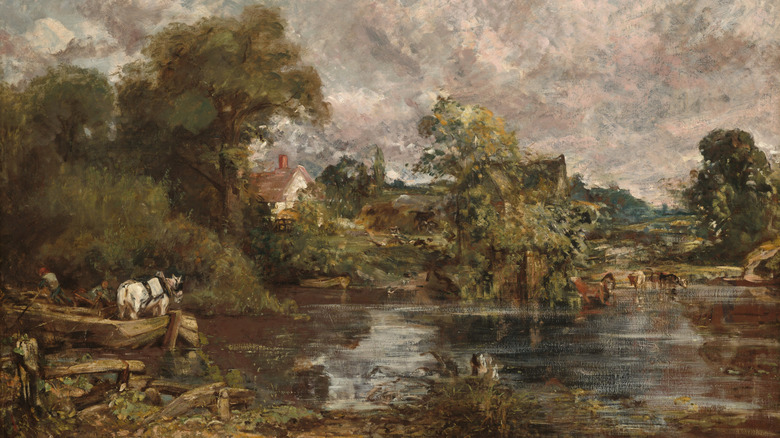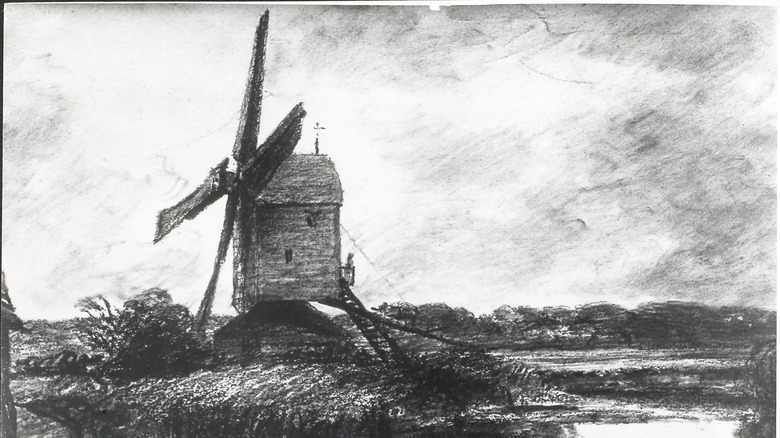The Valuable Centuries-Old Wall Art You Should Always Look For At Thrift Stores & Estate Sales
The world of thrifting is as mysterious as it is unpredictable. In a stroke of luck, you may come to find out that the antique painting your father snagged for a little over $30 is actually a John Constable (1776–1837) worth hundreds of thousands. That's exactly what happened to East London graphic designer Rob Darvell in 2013. And it's not the only episode of its kind, either. So, the next time you're at a thrift store or estate sale, look out for a centuries-old Constable in the wall art section.
In 2015, a landscape painting of Salisbury Cathedral previously believed to be authored by a follower of the 19th century artist and bought for $5,212 was re-evaluated, deemed an original, and sold for $5.2 million. And again, in 2017, when BBC researchers verified a piece formerly valued at $48,000 to be worth over $2.5 million. On other occasions, forgotten sketches were found in cupboards and old suitcases and estimated at thousands. That's why you may want to thrift your wall art instead of buying from home décor stores, because you never know what you might find.
John Constable was an incredibly prolific artist with valuable oil sketches, graphite drawings, and watercolor studies adding to an unnumbered collection of portrait and landscape paintings that are still being discovered today. His is particularly valuable work for the way it challenged British tradition. Constable's commitment to realism, especially in his famous depictions of his native Suffolk, was a significant break from the idealism practiced at the time.
The defining traits of John Constable art
If there is one landscape artist you need on your walls, it's John Constable, so it's important to know what to look out for when browsing wall art at thrift stores and estate sales. His work is synonymous with the English countryside. The humble pastoral scenes and lush greenery of his hometown, particularly the valley of the River Stour, inspired him tremendously, which was unusual for a time when landscape painting focused primarily on noteworthy, grandiose, and often mythical locations. In fact, landscapes in general were seen as a lesser art form, but that didn't deter the nature-adoring painter, who continued to perfect his craft, culminating in a series of six-foot paintings produced throughout the 1820s. Among them were some of his most renowned masterpieces, including "The White Horse" (1819) and "The Hay Wain" (1821).
Constable's technique stood out from the polished conventions of the neoclassical period. His proclivity for textured painting with varying thickness and visible brushstrokes, as well as his use of white paint speckles to convey flickering light, were ahead of his time. The idiosyncrasy of his style and unwavering dedication to landscape painting would go on to inspire the famed Barbizon School in France, which included artists like Jean-Baptiste-Camille Corot and Théodore Rousseau.
How to authenticate a John Constable piece
Authenticating your latest thrifting find is far from straightforward when it comes to valuable art pieces. Take the Salisbury Cathedral piece mentioned above. The contrasting evaluations come from two reputable, albeit rival, auction houses. The British Christie's found that the piece was not painted by Constable, while the American Sotheby's argued that it was, giving it a multi-million dollar price tag. Technological advances have streamlined the process, but certainties remain rare.
Documentation, certifications, and records of past ownership can go a long way, but those are hard to come by at thrift stores and estate sales. Then there's the issue of forgeries, both of the artwork itself and of the accompanying provenance. Not only did Constable have fans, pupils, and even a son that emulated his art, but dealers like Tom Keating were also prone to faking his signature. In time, Constable became one of the most influential landscape painters in history, with some of his pieces ranking among Britain's most expensive, so his work is naturally coveted and replicated. For instance, later in life, Constable worked with printmaker David Lucas to create a series of mezzotint etches that, regardless of the painter's involvement, are credited to Lucas and, therefore, less valuable.
In order to navigate the tricky cobwebs of antique art authentication, you may need to resort to professional forensic examination, like pigment testing, via infrared x-rays and digital microscopes, to help place an artwork in a given time period. This, combined with expert opinion and any shred of evidence you can muster, may just be enough to declare your shabby thrift find a precious piece of art history.


